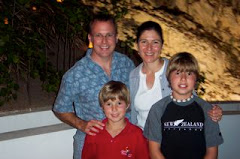Just as there are regional cultural differences in the US, Mexico's culture is different from one end of the country to the other.
Baja California is the spot in the country that is furthest away from the capital and the center of Mexican culture. Laura's school principal told her that when she was growing up, the only TV stations available were in English. Now with the digital revolution, everything is completely in Spanish (which is, perhaps, having an effect on Baja culture). In any case, Ensenada is only 100 kilometers (60 miles or so) from San Diego. Some people go up there all the time. Some people live in Ensenada an work in San Diego. Many of the elite here, especially, are professionally entwined with southern California. Many American companies do business with the "maquiladora" factories here (we're in a special economic zone along the border that encourages US companies to invest down here). So in many respects, Ensenada is much more connected to San Diego than it is to Mexico City.
Also, keep in mind that there are many US retirees in Ensenada, as well as many Americans (many of Mexican descent) that have vacation homes down here. We see tons of California license plates--I've seen three or four in the parking lots of our apartment complex.
So what seems to be the impact? We see more boys--and men--in shorts than we saw in Cuernavaca a few years ago. Coffee houses abound, and there is even a new Starbucks on the Boulevard near the cruise ship terminal. There is an Applebee's next to WalMart. The grocery stores are full of American products. The second-hand stores are equally full of American products. (Ever wonder what happens to your old washing machine? it is auctioned off to Mexicans who drag them down here by the truck load and sell them to people like me looking for a cheap Kenmore). There are not as many Indians here as there are in most other parts of Mexico; instead most of the people look fairly "white" or southern European (Laura blends right in).
That said, Ensenada is definitely Mexico. It's not Phoenix or San Diego.
As a government wonk, I see much of the difference in terms of government regulation, zoning, and political structures. In our neighborhood, right in the Zona Centro, you can have a dilapidated house or business right next to a beautiful mansion. The kindergarten of the Colegio Argentino where Laura teaches is sandwiched between a beautiful home and a used car lot. We looked at one house that was a complete wreck, but it was located right behind a very attractive strip mall. There doesn't seem to be much regulation of who can build what where, or governmental priorities about zoning. (That said, it's clear that the Avenida Reforma, which is the main north-south artery and part of the Transpeninsular Highway, is strip-zoned for commercial, and the residential neighborhoods are off the side streets). The boys noticed that the WalMart and HomeDepot are just steps from the beach. As a casual and uninformed observer, this sort of civic decision is jarring.
I know that one of the most difficult reforms that successive Mexican governments have tried to push through have been land reforms. Land ownership in this country has always been a little screwy, with some land privately held, and some held in common by the "ejidos." I haven't really figured this out yet, but land tenure is part of the problem. So government regulation has to deal with these separate land tenure structures.
Anyway, what I'm getting at is that despite the fact that Ensenada and Baja California, in general, are cultural and economically much more tied to San Diego and northwards than to Mexico City, the fact is that Ensenada is a Mexican city.
I'll write more as I begin to understand this place better.
Subscribe to:
Post Comments (Atom)




1 comment:
Hi Mark! I hope that your family continues to enjoy Ensenada. I'm here in San Diego getting started with my Grad Degree. Let me know if I can take you out to lunch sometime in SD!
Netta
Post a Comment